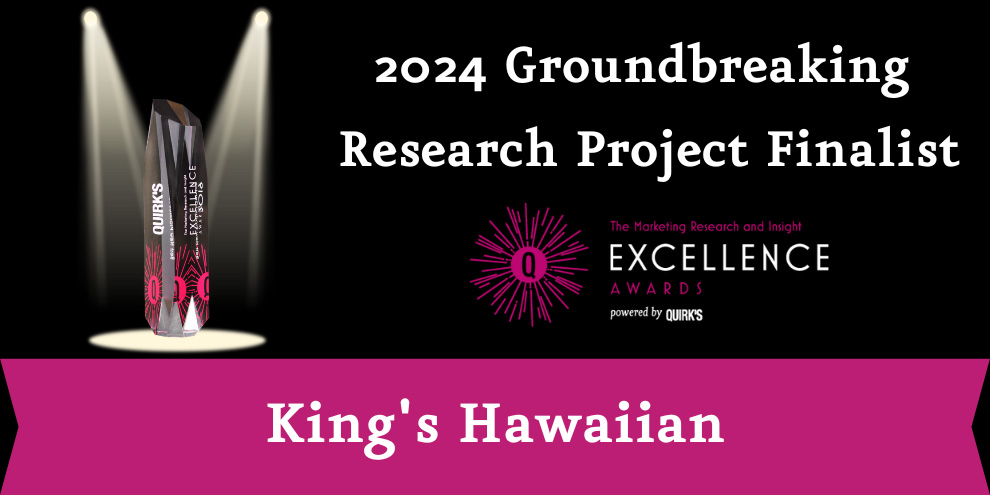Q&A with 2024 Groundbreaking Research Project award finalist, King’s Hawaiian
Editor’s Note: King’s Hawaiian is a finalist of the 2024 Groundbreaking Research Project award, a category in the Marketing Research and Insight Excellence Awards. The winners of the awards will be announced on November 19 during a virtual celebration. To find out more about the awards, visit QuirksAwards.com.
King’s Hawaiian is one of four finalists of the 2024 Groundbreaking Research Project Award, a category in the Marketing Research and Insight Excellence Awards. The innovation team at King’s Hawaiian created a new research experience for its consumers in this project.
The leadership team at the company felt that AI and other online tools, while fast and great in their abilities, were too out of touch with the actual consumers. So, the innovation team created a pop-up “restaurant” experience to test over 30 products.
Elizabeth Lee, senior manager of innovation discovery, is part of the team that created and worked on this project. Lee gave some insight into the project that earned the team a finalist position in the Groundbreaking Research Project category.
“One of [the participants] said the sample would go great with cream cheese. Then actually opened up a packet of cream cheese they’d just bought from the grocery store to try it out and made a little charcuterie plate with her deli meat as well,” Lee said.
Read more about the creative way King’s Hawaiian brought the human back into their marketing research.
Why did King’s Hawaiian decide to create an experiential innovation research method?
At King’s Hawaiian, we have high expectations for our products. We strive to deliver the most irresistible of foods. However, it was proving difficult to measure “irresistibility” at the scale, speed, cost and depth that we wanted!
The executive team challenged us with bringing the human back in research and finding a different methodology that would allow us to:
- Rapidly test a large number of flavors and prototypes.
- Iterate and evolve prototypes throughout the process – not just at the end of it.
- Talk directly to – in person – multiple generations of consumers from Gen Alpha to Boomers.
This is when we introduced “The Bites Experience” – an experiential innovation research method that allowed us to bring qual-at-scale while still feeling confident that we were targeting and talking to the right consumers.
Fun fact, King’s Hawaiian started as a small bakeshop! So, we went back to our restaurant roots with “The Bites Experience,” which emulated food pop-up restaurants. We had the entire set up – banners, uniforms, a menu board and a QR order form, and “charged” $1 a cup. But instead of taking the consumer’s money, we asked them to give us their feedback.
In just one month, we set up six pop-ups across Los Angeles and focused on areas where we knew we would find our target consumers – grocery stores, football tailgates, restaurants and bakeries. Not only did we iterate and test more than 30 flavors, but the entire team spoke to over 400 consumers!
What was the most challenging aspect of this project? How were you able to overcome it?
The most challenging aspect of this project was executing at the rapid speed the project needed, without having ever done it before.
It was the first time our team iterated weekly on the fly with new product flavors and formulations, so the chef team had to think of clever ways to make large amounts of product without compromising quality.
Additionally, we had to design a booth that was convincing enough to look like a food service pop-up and was portable enough to bring to different locations every week. Our last pop-up was at the tailgate section of a huge college football game so we had to redesign and rethink our approach to make sure that we could account for the large volumes of people who would come through.
Additionally, to manage expectations from our stakeholders and keep the project moving quickly without too many pivots, I sent updates after every pop-up to talk through the flavors that were “selling” the best and any red flags we saw along the way as consumers tasted our products.
A big mahalo to the former and current executive and management team for being scrappy and thinking through rapid solutions every week during the lifetime of this project.
Would you change anything about the project?
We could have been better at fostering in-person conversations. We relied more on paper surveys so that the consumers would have to have a conversation with each of the “workers” to record their responses, rather than filling out a survey online.
We found previously that online surveys lead to more disconnection and lower response rates, but this meant that we had hundreds of paper surveys to input into a spreadsheet later to do analysis.
To make the analysis more efficient, we did a debrief after every pop-up to talk through our big findings. However, moving forward, I would find a more streamlined way to look at and input the data.
